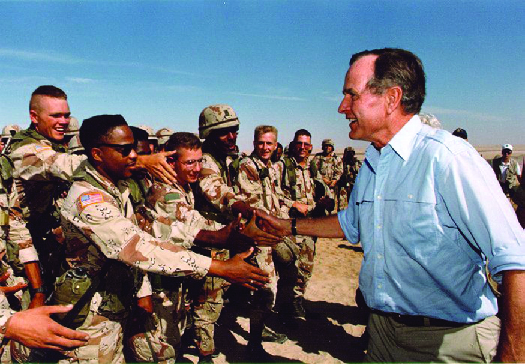| << Chapter < Page | Chapter >> Page > |
At the more serious end of the foreign policy decision-making spectrum, and usually as a last resort when diplomacy fails, the U.S. military and defense establishment exists to provide the United States the ability to wage war against other state and nonstate actors. Such war can be offensive, as were the Iraq War in 2003 and the 1989 removal of Panamanian leader Manuel Noriega . Or it can be defensive, as a means to respond to aggression from others, such as the Persian Gulf War in 1991, also known as Operation Desert Storm ( [link] ). The potential for military engagement, and indeed the scattering about the globe of hundreds of U.S. military installations, can also be a potential source of foreign policy strength for the United States. On the other hand, in the world of diplomacy, such an approach can be seen as imperialistic by other world nations.

Intelligence policy is related to defense and includes the overt and covert gathering of information from foreign sources that might be of strategic interest to the United States. The intelligence world, perhaps more than any other area of foreign policy, captures the imagination of the general public. Many books, television shows, and movies entertain us (with varying degrees of accuracy) through stories about U.S. intelligence operations and people.
Foreign aid and global environmental policy are the final two foreign policy types. With both, as with the other types, the United States operates as a strategic actor with its own interests in mind, but here it also acts as an international steward trying to serve the common good. With foreign aid, the United States provides material and economic aid to other countries, especially developing countries, in order to improve their stability and their citizens’ quality of life. This type of aid is sometimes called humanitarian aid; in 2013 the U.S. contribution totaled $32 billion. Military aid is classified under military/defense or national security policy (and totaled $8 billion in 2013). At $40 billion the total U.S. foreign aid budget for 2013 was sizeable, though it represented less than 1 percent of the entire federal budget.
Global environmental policy addresses world-level environmental matters such as climate change and global warming, the thinning of the ozone layer, rainforest depletion in areas along the Equator, and ocean pollution and species extinction. The United States’ commitment to such issues has varied considerably over the years. For example, the United States was the largest country not to sign the 1997 Kyoto Protocol on greenhouse gas emissions. However, few would argue that the U.S. government has not been a leader on global environmental matters.

Notification Switch
Would you like to follow the 'American government' conversation and receive update notifications?